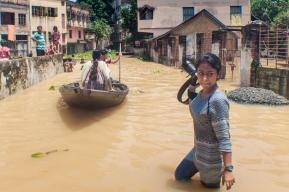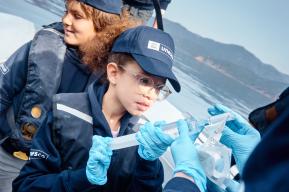观点
拉丁美洲向塑料宣战

拉丁美洲大陆正在通过越来越多的项目,鼓励人们深入了解海洋环境,帮助打造某种形式的“海洋公民身份”。
罗德里戈·托雷斯(Rodrigo Torres)和萨米拉·费雷拉(Samila Ferreira)
托雷斯,海洋、海岸和水下考古学家,乌拉圭共和国大学海岸遗产研究中心(CIPAC)的一名教授;
费雷拉,上述海岸遗产研究中心的一名文化人类学家、研究员。
本项目源自巴西东北海岸线上的巴伊亚州萨尔瓦多市,始于2010年“忏悔星期二”狂欢节后的第一天。在那个一年一度的大众节日里,数百万人上街游行,载歌载舞。在目睹狂欢节结束后海洋中垃圾如山的景象之后,四名冲浪者决心采取行动。他们创立了节日基金 ,旨在清理被倾倒入海洋中的垃圾。
在巴西,节日基金已经从海底收集了数吨垃圾
如今10年过去,这个协会并没有消失,甚至还在不断发展壮大。现在,科学家和当地居民都加入了这场行动,毫不犹豫地潜入海底清理垃圾。他们没有氧气瓶,只能靠坐在桨板上的志愿者给予帮助。
这项举措将体育运动与环保意识结合在一起,开展了200多项活动,清理了海底数百吨垃圾。2019年,该项目覆盖的地区被宣布为市级保护区。巴拉海洋公园——巴西首个城市海洋保护区就此诞生。
拉丁美洲日益认识到遏制海洋污染的必要性,除了这项当地举措外,拉丁美洲还开展了海滩清理项目,在学校里举办宣传讲习班,在社交网络上进行“零垃圾”运动,等等。
塑料岛
媒体和社交网络上曾经流传着这样一组照片:海滩成了垃圾场,海龟因吞下了塑料袋而溺水死去。这些照片对公众产生了巨大影响。我们周围的海域充斥着大量垃圾:据估计,每年约有800万吨塑料制品被倒入海洋。世界自然基金会的数据显示,拉丁美洲是全球第四大塑料垃圾制造者。
每年有800万吨塑料制品被倒入海洋
然而,这些塑料垃圾中大部分都被冲上海滩、漂浮在海洋表面,或者分解成微小颗粒侵入海床。如今我们知道,在距离智利海岸约1 000千米的海域,塑料制品堆积程度令人震惊——部分区域每平方千米的塑料碎片多达5万片。
以塑料吸管这种随处可见的典型的一次性用品为例,它们可能需要100年的时间才能分解完毕。阿根廷、巴西、智利和墨西哥等若干拉丁美洲国家都已加入禁止使用塑料吸管的全球倡议,并在社交网络上发起了旨在提高人们对塑料吸管毒性认识的运动。
相比塑料垃圾问题的严重程度来说,开展这些运动似乎只是杯水车薪。虽然吸管只占海洋废物总量的很小的一部分,但这些运动却能够更广泛地提高公众对于处置无处不在、看似无害的塑料用具所产生的负面影响的认识。这些运动还会促使我们思考自己的消费习惯,以及我们的日常行为对环境造成的影响。
全方位介绍海洋
除了这些举措,传播教育和教学资源也可以提高公众认识。这不仅能让年轻人更好地了解支配海洋的复杂物理、化学和气候现象,而且有助于改变我们对海洋的看法,重塑我们与海洋的关系。
在一个日益高度互联的世界里,数字技术为海洋信息的介绍提供了很多有趣的可能性。例如,乌拉圭开发了“船舶之路:开发马尔多纳多湾海洋景观虚拟博物馆”项目,为公众展示关于保护乌拉圭海洋和水下文化遗产相关问题的信息。该项目还提出教育体验和娱乐体验,利用创新技术让人们走近科学研究。
项目计划通过三维模型展示与该地区海洋历史有关的标志性地点,利用虚拟和增强现实技术举办关于航海人员、船舶、历史航线和海洋景观的展览。
项目目标是利用数字文化提供的可能性,鼓励公众成为文化遗产的主人,鼓励大家探索塑造了人与海洋关系的视角变化、身份构建以及归属感。
除了方法上的不同,这些举措拥有一个共同的主线:它们促使我们思考我们能为海洋做些什么,而不是海洋能为我们做些什么。
拓展阅读:
《欢迎来到人类世!》,联合国教科文组织《信使》,2018年4-6月。
《水晶宫里的沉船》,联合国教科文组织《信使》,2017年10-12月。
订阅联合国教科文组织《信使》,阅读发人深省的时事文章,数字版免费。
在社交网络上关注联合国教科文组织《信使》:微博、微信公众号“联合国教科文信使”、Twitter、Facebook、Instagram。
By Rodrigo Torres and Samila Ferreira
The project started in 2010 in Salvador de Bahia, on Brazil’s north-eastern coast, the day after the Mardi Gras carnival. Observing the mountains of garbage thrown into the sea after the popular annual festival – during which millions of people take to the streets to dance and participate in the parade – four surfers decided to take action. They created O Fundo da Folia (the Festival Fund) to clean up the waste that had been dumped into the sea.
In Brazil, the Fundo da Folia has collected hundreds of tons of waste from the sea floor
A decade later, the association still exists, and has even grown through the years. Scientists and local residents now participate in the operation, not hesitating to dive to the bottom of the sea to clean up the rubbish. They have no oxygen cylinders and are helped only by volunteers perched on paddle boards.
More than 200 activities have already been launched as part of this initiative, which combines sport with environmental awareness, and has cleaned out hundreds of tons of waste from the sea floor. In 2019, the area covered by the project was declared a protected zone at the municipal level. As a result, the Barra Marine Park, Brazil's first marine reserve in an urban context, was established.
This local initiative is just one example of the growing awareness in Latin America of the need to combat marine pollution – that includes beach clean-up projects, awareness-raising workshops in schools, “zero waste” campaigns on social networks, etc.
Plastic islands
The images circulated by the media and on social networks – of beaches that have turned into garbage dumps and of turtles drowning after ingesting plastic bags – have had a great impact on the general public. The seas around us are overflowing with garbage: an estimated eight million tons of plastic are dumped into the ocean every year. According to the World Wildlife Fund (WWF), Latin America is the fourth-largest producer of plastic waste in the world.
Eight million tons of plastic are dumped into the ocean every year
However, a significant part of this waste washes up on beaches, drifts on the surface of the ocean, or invades the seabed by decomposing into micro-particles. Today we know that about a thousand kilometres from the Chilean coast, there is an alarming concentration of plastics in the ocean – up to 50,000 pieces of debris per square kilometre in some areas.
Plastic straws, for example, which can take a hundred years to decompose, are typical of the single-use objects that have invaded our daily lives. Several Latin American countries – including Argentina, Brazil, Chile and Mexico – have joined global initiatives to ban the use of plastic straws, and have launched campaigns on social networks to raise awareness of their toxicity.
These campaigns may seem trivial, considering the scale of the problem. Yet, though straws represent only a tiny part of the total volume of marine waste, these campaigns contribute to a much wider public awareness of the negative effects of the disposal of seemingly harmless plastic utensils, which are ubiquitous. They also encourage us to think about our consumer habits and the impact of our daily actions on the environment.
The sea in 3D
In addition to these initiatives, raising public awareness also involves the dissemination of educational and teaching resources. This enables young people not only to better understand the complex physical, chemical and climatic phenomena that govern the ocean, but also to help change our perception of, and our relationship with it.
In an increasingly hyperconnected world, digital technologies offer interesting possibilities in this respect. In Uruguay, for example, a project called Route of the Vessels: Developing a Virtual Museum of the Maritime Landscape of Maldonado Bay provides information on issues related to the preservation of maritime and underwater Uruguayan cultural heritage. It proposes educational and recreational experiences, using innovative technologies to familiarize people with scientific research.
The programme includes the three-dimensional modelling of iconic sites linked to the region’s maritime history, using virtual and augmented reality to create exhibitions on seafaring people, their boats, historical routes and maritime landscapes.
The goal is to take advantage of the possibilities provided by digital culture to encourage the public to take ownership of their cultural heritage – and to explore the changes in perspective that have shaped people’s relationship to the sea, the construction of identities, and the sense of belonging.
Beyond their differences in approach, these initiatives have a common thread: they make us think not about what the ocean can do for us, but about what we can do for the ocean.
Rodrigo Torres and Samila Ferreira
A maritime, coastal and underwater archaeologist, Torres is a professor at the Center for Coastal Heritage Research (CIPAC), of the University of the Republic, Uruguay.
Ferreira is a cultural anthropologist and researcher at CIPAC.







